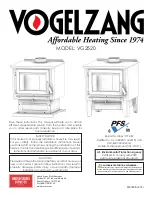
-10-
Operation
WOOD STOVE UTILIZATION
The operation of this wood heater in a manner inconsistent with the owner’s manual will void your warranty and is
also against federal regulations. This heater is designed to burn natural wood only. Higher efficiencies and lower
emissions generally result when burning air dried seasoned hardwoods, as compared to softwoods or too green
or freshly cut hardwoods.
DO NOT BURN:
1. Garbage;
2. Lawn clippings or yard waste;
3. Materials containing rubber, including tires;
4. Materials containing plastic;
5. Waste petroleum products, paints or paint thinners,
or asphalt products;
6. Materials containing asbestos;
7. Construction or demolition debris;
8. Railroad ties or pressure-treated wood;
9. Manure or animal remains;
10. Saltwater driftwood or other previously salt water-
saturated materials;
11. Unseasoned wood; or
12. Paper products, cardboard, plywood, or
particleboard. The prohibition against burning
these materials does not prohibit the use of fire
starters made from paper, cardboard, sawdust,
wax, and similar substances to start a fire in an
affected wood heater.
Burning these materials may result in the release of toxic fumes or render the heater ineffective and cause smoke.
Deadwood lying on the forest floor should be considered wet and requires full seasoning time. Standing deadwood
can usually be considered to be about 2/3 seasoned. Splitting and stacking wood before it is stored accelerates
the drying time. Storing wood on an elevated surface from the ground and under a cover or covered area from
rain or snow also accelerates the drying time. A good indicator of if the wood is ready to burn is to check the
piece ends. If cracks are radiating in all directions from the center then the wood should be dry enough to burn.
If your wood sizzles in the fire, even though the surface is dry, it may not be fully cured and should be seasoned
longer.
Do not burn manufactured logs made of wax impregnated sawdust or logs with any chemical
additives. Manufactured logs made of 100% compressed sawdust can be burned, but be
careful burning too much of these logs at the same time. Start with one manufactured log and
see how the stove reacts. You can increase the number of logs burned at a time but make
sure the temperature never rises higher than 475 °F (246 °C) on a magnetic thermometer for
installation on single wall stove pipes or 900 °F (482 °C) on a probe thermometer for installation
on double wall stove pipe. The thermometer should be placed about 18” (457 mm) above the
stove. Higher temperatures can lead to overheat and damage your stove.
Waste and other flammable materials should not be burned in your stove. Any type of wood may be used in your
stove, but specific varieties have better energy yields than others. Please consult the following table to make the
best possible choice.
TYPE
WEIGHT (LBS. CU. FT., DRY)
PER CORD EFFICIENCY RANKING
SPLITS
MILLIONS BTU’s/CORD
Hickory
63
4500
1.0
Well
31.5
White Oak
48
4100
.9
Fair
28.6
Red Oak
46
3900
.8
Fair
27.4
Beech
45
3800
.7
Hard
26.8
Sugar Maple
44
3700
.6
Fair
26.2
Black Oak
43
3700
.6
Fair
25.6
Ash
42
3600
.5
Well
25.0
Yellow Birch
40
3400
.4
Hard
23.8
Red Maple
38
3200
.3
Fair
22.6
Paper Birch
37
3100
.3
Easy
22.1
Elm/
Sycamore
34
2900
.2
Very
Difficult
20.1
Red Spruce
29
1800
.1
Easy
16.1
Summary of Contents for VOGELZANG VG2520
Page 17: ...17 Notes...
Page 18: ...18 Notes...

























